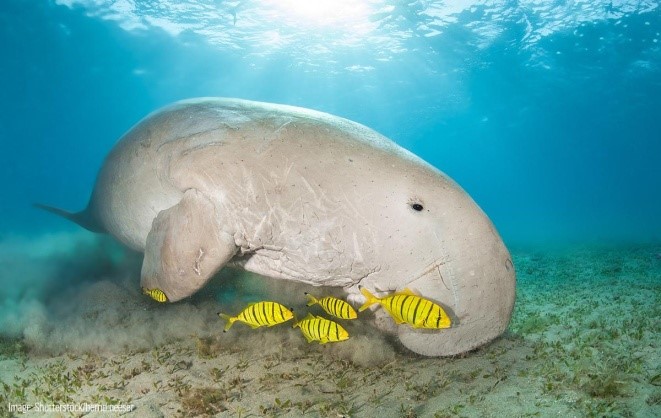Description

Disclaimer: Copyright infringement not intended.
Context:
- India’s first Dugong conservation reserve will be built in Tamil Nadu’s Palk Bay for the conservation of Dugong.
- Dugong is a marine animal that has been enlisted vulnerable to extinction on a global scale by the World Conservation Union (IUCN).
Dugong Conservation Reserve
- The reserve will spread over an area of 500 km in Palk Bay on the southeast coast of Tamil Nadu.
- Palk Bay is a semi-enclosed shallow water body with a water depth maximum of 13 meters.
- Located between India and Sri Lanka along the Tamil Nadu coast, the dugong is a flagship species in the region.
Dugong: The sea cow
- Dugong or the sea cow is the State animal of Andaman & Nicobar Islands.
- This endangered marine species survive on seagrass and other aquatic vegetation found in the area.
- It is the only herbivorous mammal that is strictly marine and is the only extant species in the family Dugongidae.
- Dugongs are usually about three-meter long and weigh about 400 kg.
- Dugongs have an expanded head and trunk-like upper lip.
- Elephants are considered to be their closest relatives. However, unlike dolphins and other cetaceans, sea cows have two nostrils and no dorsal fin.
- Distributed in shallow tropical waters in the Indo-Pacific region, in India, they are found in the Gulf of Kutch, Gulf of Mannar, Palk Bay, and Andaman & Nicobar Islands.
Causes of extinction
- It has been declared vulnerable in the IUCN list.
- Reasons for the extinction are: slow breeding rate, fishing, and the loss of habitat.
- Dugongs are long-living animals, that have a low reproductive rate, long generation time, and high investment in each offspring.
- The female dugongs do not bear their first calf until they are at least 10 and up to 17 years old.
- Natural and human induced activities: Due to natural and human-induced activities, the natural habitat of the animal is on a risk. The herbivorous mammal feeds on seagrass, which is at a loss. Human activities such as riding of speed-boats causes death of the animal due to boat and propellor strikes. Further, habitat loss is also attributed to the increase in conversion of coastal forests to banana, areca nut, and coconut plantations and high boat traffic.
- Natural factors are extreme weather events such as cyclones and high energy tidal storms may also contribute to the loss of seagrasses in the region.
- Gill-net fishing: Dugongs are also known to suffer due to accidental entanglement and drowning in gill-nets. Fishing activities around the Indian, Andaman, Nicobar, and Sri Lankan coasts include gill netting and dynamite fishing.
How the population can thrive?
- The conservation reserve can promote growth and save the vulnerable species from the verge of extinction.
- Dugongs are protected in India under Schedule 1 of the Indian Wildlife Act 1972, which bans the killing and purchasing of dugong meat.
- According to the United Nations Environment Programme (UNEP) report on dugong, there are no quantitative data on the status of dugongs or the extent or nature of seagrass communities along the coast of the Indian subcontinent or the associated offshore islands.
- However, conservation measures like the proposed conservation area can help revive the sea cow population.
- Simultaneous effort towards seagrass meadow restoration, reduction of dugong mortalities, and community participation in dugong conservation can help in helping the dugong population recover.
- It also calls for creating awareness among the people, involving the local communities.
https://newsonair.com/2021/09/09/first-dugong-conservation-reserve-to-be-built-in-india/











